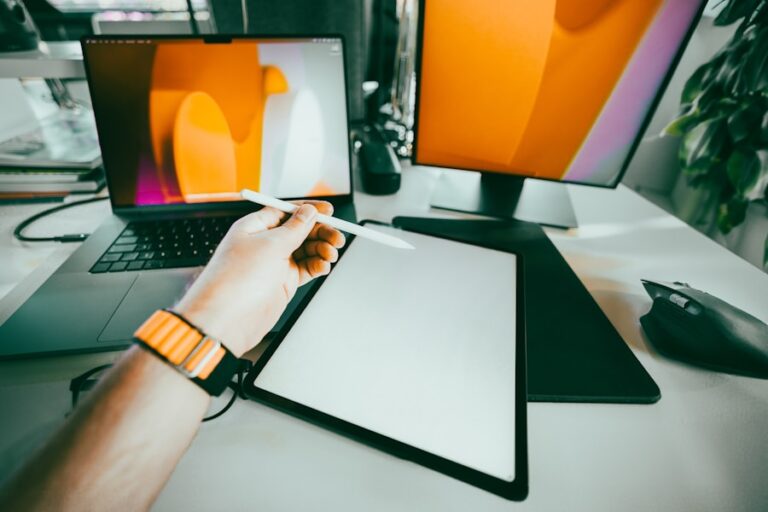Unleashing the Power of Technology: 8 Mind-Blowing Digital Artwork Examples
Digital artwork is a form of artistic expression that utilizes digital technology as a medium. It encompasses a wide range of creative practices, including digital painting, 3D modeling, animation, and interactive installations. Unlike traditional art forms, digital artwork is created and displayed using electronic devices such as computers, tablets, and smartphones. This allows for greater flexibility and accessibility, as digital art can be easily shared and distributed online. The rise of digital art has revolutionized the way we create, consume, and interact with visual media, opening up new possibilities for artistic expression and communication.
The Evolution of Digital Art
The history of digital art can be traced back to the 1950s, when computer technology first began to emerge as a tool for artistic experimentation. Early pioneers such as Ben Laposky and Frieder Nake used computers to generate abstract patterns and images, laying the groundwork for the development of digital art as a distinct artistic practice. In the 1980s, the introduction of personal computers and graphic design software further expanded the possibilities of digital art, allowing artists to create and manipulate images with unprecedented precision and control. The advent of the internet in the 1990s brought about a new era of digital art, as artists began to explore the potential of online platforms for sharing and exhibiting their work. Today, digital art continues to evolve with advancements in technology, encompassing a diverse range of styles and techniques that push the boundaries of traditional artistic practice.
The Impact of Technology on Art
The integration of technology into the art world has had a profound impact on the way we create, experience, and understand visual culture. Digital tools and software have democratized the process of art-making, making it more accessible to a wider audience and allowing for greater experimentation and innovation. Artists are no longer limited by traditional materials and techniques, as digital technology enables them to explore new forms of expression and push the boundaries of visual storytelling. Additionally, the internet has transformed the way we consume and engage with art, providing a global platform for artists to showcase their work and connect with audiences from around the world. As technology continues to advance, the possibilities for artistic creation and collaboration are endless, opening up new avenues for creativity and cultural exchange.
Mind-Blowing Examples of Digital Artwork
One of the most iconic examples of digital artwork is “The Treachery of Images” by René Magritte, which challenges our perception of reality through a hyperrealistic depiction of a pipe accompanied by the text “Ceci n’est pas une pipe” (This is not a pipe). This thought-provoking piece blurs the line between representation and reality, inviting viewers to question the nature of visual representation and the role of language in shaping our understanding of the world. Another groundbreaking example of digital art is “Starry Night” by Vincent van Gogh, which has been reimagined in a mesmerizing animated version that brings the iconic painting to life through dynamic movement and color. This innovative interpretation demonstrates the transformative power of digital technology in reinterpreting and recontextualizing traditional works of art.
Exploring the Boundaries of Digital Art
Digital art has opened up new possibilities for exploring the boundaries of artistic practice, challenging traditional notions of medium, materiality, and authorship. Artists such as Rafael Lozano-Hemmer and Olafur Eliasson have embraced digital technology as a means of creating immersive and interactive installations that engage viewers in new ways. These works often incorporate elements of light, sound, and motion to create multisensory experiences that blur the line between art and technology. Additionally, advancements in 3D printing and virtual reality have enabled artists to push the boundaries of physical space and perception, creating artworks that exist beyond the confines of traditional exhibition spaces. As digital art continues to evolve, artists are increasingly exploring the potential of artificial intelligence and machine learning as tools for generating new forms of visual expression, further expanding the possibilities for creative experimentation and innovation.
The Future of Digital Art
The future of digital art holds endless possibilities for innovation and creativity, as artists continue to push the boundaries of technological advancement in their practice. As virtual reality and augmented reality technologies become more accessible, we can expect to see new forms of immersive and interactive digital art that redefine our relationship with space and perception. Additionally, advancements in artificial intelligence and machine learning are likely to revolutionize the way we create and experience visual media, opening up new avenues for collaboration between human artists and intelligent algorithms. The integration of blockchain technology also holds potential for transforming the way we collect, authenticate, and exchange digital artworks, providing new opportunities for artists to monetize their work and connect with global audiences. As digital art continues to evolve, it will undoubtedly play an increasingly significant role in shaping our cultural landscape and challenging our understanding of artistic practice.
Embracing the Power of Technology in Art
In conclusion, digital art represents a dynamic and transformative force within contemporary visual culture, offering new opportunities for creative expression, collaboration, and engagement. The evolution of digital art has been shaped by advancements in technology, which have expanded the possibilities for artistic practice and redefined our relationship with visual media. As we look to the future, it is clear that digital art will continue to play a vital role in shaping our cultural landscape, challenging traditional notions of medium, materiality, and authorship. By embracing the power of technology in art, we can foster new forms of creativity and cultural exchange that transcend traditional boundaries and inspire new ways of seeing and understanding the world around us.





